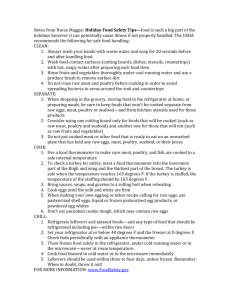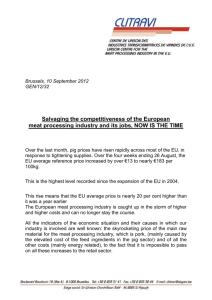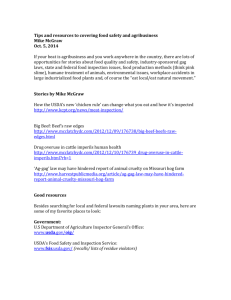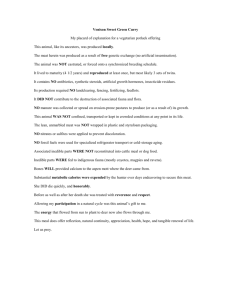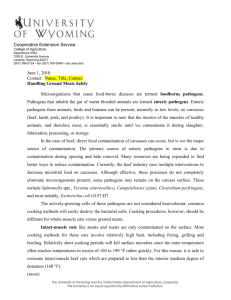History of Consumer Food Safety Education Focus
advertisement
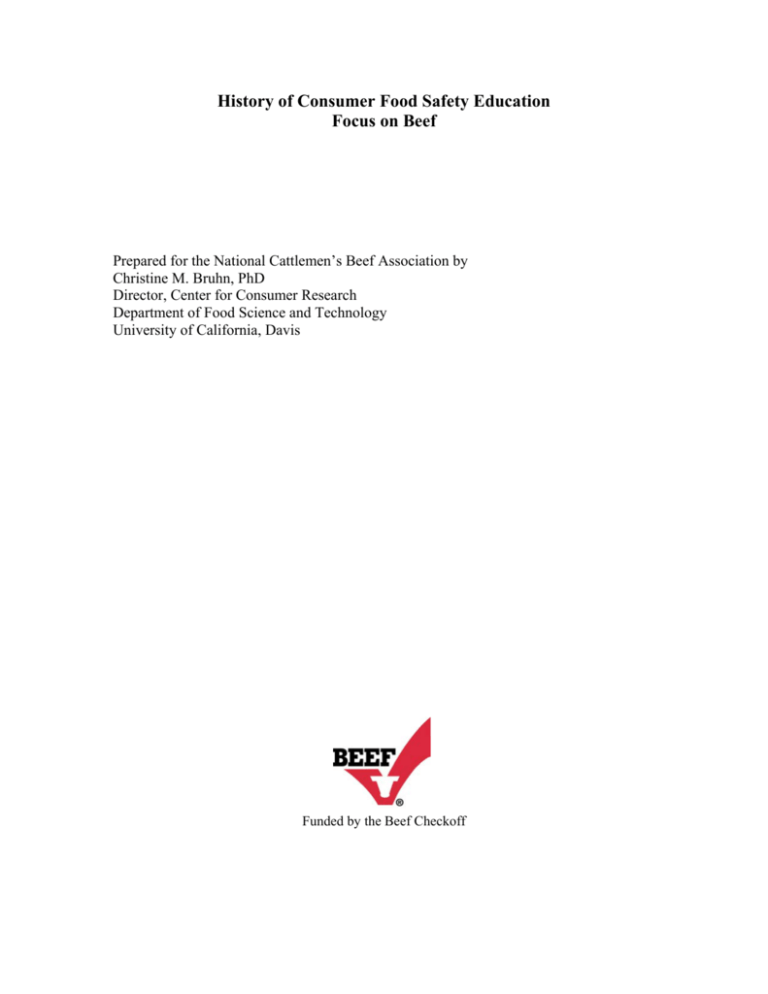
History of Consumer Food Safety Education Focus on Beef Prepared for the National Cattlemen’s Beef Association by Christine M. Bruhn, PhD Director, Center for Consumer Research Department of Food Science and Technology University of California, Davis Funded by the Beef Checkoff History of Consumer Food Safety Education In the past, public concern about food safety appeared to be limited to chemical contamination, pesticide residues, and the occasional case of stomach flu that made the victim miserable for a few hours. In recent years, the public has come to release that microbiological safety can have serious, long term consequences. This paper traces the history of consumer food safety educational programs over the last three decades by examining food safety references and the content of educational material. Over this period advice to the consumer has evolved from general guidelines to specific targeted messages. Changes in consumer knowledge and behavior as indicated by surveys and actual observation indicate that programs have had a positive but limited effect. Educational Programs Food safety education is delivered by the federal government through the US Food and Drug Administration (FDA) and the US Department of Agriculture (USDA). States are involved in development and delivery of educational programs through Cooperative Extension at land grant institutions. Food industry organizations engage in general or product specific information on safe handling often combined with guidelines on selection and preparation for flavorful dishes. Since the late 1990s a partnership of government, food industry, educators, and non-government organizations have played a major role in defining and delivering food safety information. Food Safety Over the Decades Awareness of pathogens and food safety messages has evolved over the last three decades. Textbooks used in college and university food science classes designed for home economists and dietitians provide only a cursorily overview of food safety. Classic text books published in the 1950s and 1960s address the chemical, physical and nutritional changes that took place in food during food preparation, but do not address food safety. (Lowe 1955; Griswold 1962; Charley 1970) Botulism, staphylococcal food poisoning, salmonellosis and C. perfrigens are briefly mentioned by Bennion in 1980. (Bennion 1980) A more extensive discussion of food safety is included in Foundations of Food Preparation, which was published in 1987. (Freeland-Graves and Peckham 1987) Major pathogens, such as Clostridium botulinum and Salmonella are mentioned, but E coli is not identified. The authors state that the most important factors to prevent foodborne illness are the application of heat, adequate refrigeration, safe thawing, length of storage, storage conditions, and proper sanitation. Details are provided on appropriate refrigerator temperature and storage time; however end cooking temperatures are only indicated for stuffed turkey. Information from the US FDA food safety material in the early 1980s is more extensive than that in college level textbooks, however food safety guidelines lack specific details that would result in safe handling. For example, “Who, Why, When and Where of Food Poisons (And What To Do About Them)” published in the FDA Consumer reports that Salmonella could be found in raw meat. (Ballentine and Herndon 1982) To prevent 2 History of Consumer Food Safety Education foodborne illness, readers are advised to handle food in a sanitary manner, cook foods thoroughly, and promptly and properly refrigerate foods. Similarly the discussion of staphylococcal food poisoning indicates that a toxin is formed when food including meat is held at room temperature too long. Advice for preventing this condition, the same general precautions associated with Salmonella control, is repeated here. People are advised to handle food in a sanitary manner with prompt and proper refrigeration. Since details of handling are not specified, consumer adoption of effective food handling practices is unlikely. Food safety material developed by USDA ten years later is more specific. The publication, Is Someone you know at risk for foodborne illness? identifies people at increased risk as seniors, pregnant women, children, and people with a weakened immune system. (United States Department of Agriculture 1990) Written in a proactive way, readers are encouraged to “take control” to reduce the risk for foodborne disease. The reasons why people with specific health conditions are more vulnerable to foodborne illness is explained in a clear and understandable manner. Specific handling guidelines are provided for shopping, cold storage, safe thawing, proper food preparation, serving, and handling leftovers. The recommended temperature for the home refrigerator is specified at 40°F or colder, and readers are advised to cook ground meat to 160°F. Other publications by USDA provide specific recommendations consistent with current knowledge of foodborne illness. Food News for Consumers, for example, recommends that foods should be marinated in the refrigerator, foods should be cooked completely rather than partially cooked, held and reheated, and meat should be cooked to 160°F. (Moriarty 1991) Similarly, A Quick Consumer Guide to Safe Food Handling includes specific information as to temperature control and safe storage time. (United States Department of Agriculture 1990) USDA’s Meat and Poultry Hotline, established in 1985, provides answers to consumer questions both through a toll free telephone call, fact sheets, articles in educational publications such as Food News, and fact sheets available through the internet. (United States Department of Agriculture 1996) The Hot Line representatives also respond to media calls, reaching an even larger audience. Another USDA consumer publication, Preventing Foodborne Illness, provides detailed food handling information. (United States Department of Agriculture 1990) Sections are devoted to safe shopping, storage, preparation, serving, and handling of leftovers. E coli O157:H7 is mentioned and consumers are advised to cook ground beef to 160°F. Listeria is discussed and pregnant women are identified as being at increased risk for this pathogen. Those at high risk are advised to reheat processed meats. In 1991, the US FDA also provided more comprehensive and specific consumer food safety guidelines. Preventing Food-Borne Illness provides foodborne illness prevention tips including sections on cleaning and cooking, safe storage with recommended storage times, symptoms and sources of bacteria and sources for additional information. (Anonymous 1991) The minimum recommended cooking temperatures for beef is 140°F. 3 History of Consumer Food Safety Education A higher temperature for ground beef is not advised. Although this document was reprinted and revised in 1997, a recommended end point cooking temperature for ground beef was not added. College text books published in the 1990s reflect a more comprehensive coverage of foodborne illness. Food Safety, by Julie Jones, includes a discussion of significantly more microbial pathogens than books from the previous decade including Salmonella, Camplybacter jejuni, Toxoplasma gondi, Staphlococcus aureus, Clostridium perfringenes, Shigella, Escherichia coli, Trichinella spiralis, Bacillus cereus, Vibrio, Listeria monocytogenes, Yersinia enterocolitica, and others. Raw meat and meat products are identified as a source of Salmonella, Clostridium perfringens, and Listeria monocytogenes. Jones notes that E. coli is a common resident of the intestinal tract of warm-blooded animals. She notes that for many years it had been considered harmless; however particular strains of E coli were the cause of enteric disease in the 1980s with soft cheeses and ground beef identified as the food source. Sanitary handling to avoid cross contamination, thorough cooking and keeping foods out of the danger zone are specified as ways to reduce the probability of illness. Consumers indicate that they obtain safe handling information from cook books and magazines. (Ralston, Starke et al. 2000) A review of classic cookbooks, such as Better Homes and Gardens or Joy of Cooking, indicates virtually all limit food handling information to culinary issues such as the temperature for roasts cooked to rare, medium or well done. Even books published in the1990s and later specializing in ground beef or grilling address preference for degree of doneness rather than food safety considerations. There are exceptions. The 1997 edition of Joy of Cooking lists the recommended end point temperature for meat loaf is 160°F (page 722) but incorrectly advises consumers to cook ground beef to 155°F ( page 646). (Rombauer, Becker et al. 1997) Further, readers are advised that risk is lessened by buying top-grade beef and grinding it themselves. This is a potentially risky practice since the opportunity for cross contamination in the kitchen is high. Some cookbooks provide current, accurate information. The Complete Meat Cookbook, for example, recommends 160°F or 155°F for 15 seconds as the end point cooking temperature for ground beef. (Aidells and Kelly 1998) Landmark Food Safety Event A landmark event in food safety occurred in 1993. Consumption of undercooked hamburger contaminated with E coli O157:H7 resulted in 501 illnesses, 151 hospitalizations, and 3 deaths. (Bell, Goldoft et al. 1994) This outbreak received extensive publicity because the source of illness was a popular food and many victims were children. In 1994, USDA declared E coli O157:H7 an adulterant in raw beef and a program began to test for the pathogen in raw ground beef from federally inspected establishments and retail stores. (Crutchfield and Roberts 2000) In 1994, the public was advised to cook ground beef until it is brown and juices run clear; however in 1997 FSIS revised this recommendation. Cooked ground beef color was showed to not accurately predict end point temperature. Consumers were advised to use a meat thermometer and cook to 160°F rather than rely on color. 4 History of Consumer Food Safety Education Since 1994, USDA has required safe food-handling labels on retail packages or raw and partially cooked meat and poultry products. The label advises consumers to refrigerate the product, avoid cross contamination, cook thoroughly, and keep hot food hot, and handle leftovers properly. Interview and survey data indicate that 51% or more of consumers contacted recalled seeing the label. Of these, 79% or more remember reading the label, and 37% of these said they changed the way they handle raw meat as a result of reading the label. (Shiferaw, Yand et al. 2000; Yang, Angulo et al. 2000; Raab and Woodburn 2001) These studies found people were more likely to remember the message to avoid cross contamination than any other. In 1997 President Clinton announced the National Food Safety Initiative. (Crutchfield and Roberts 2000; Partnership for Food Safety 2008) This measure established the Partnership for Food Safety Education, a not-for-profit organization of government agencies, food industry, nutrition/food safety professional societies, and consumer groups. The Partner’s mission is to educate consumers to protect themselves from bacteria (BAC) and reduce risk of foodborne illness by following 4 simple practices: CLEAN: Wash hands and surfaces often SEPARATE: Don't cross-contaminate! COOK: Cook to proper temperature CHILL: Refrigerate promptly The partnership provides a coordinated and consistent set of food safety messages based upon consumer-tested information and graphics. Messages are developed through public opinion research and expert scientific and technical review. Information is distributed through mass media, public service announcements, the Internet, point-of-purchase, and school and community initiatives. Material is available to use nationwide by public health, nutrition, food science, education and special constituency groups. USDA, FDA and others in the Partnership sponsor a “Partner’s Toolkit” which contains flyers, posters, and a CD with additional educational material. “Consumer Education Planning Guides” mailed to food safety educators include media material such as a press release and public service announcements as well as fact sheets, Fight BAC brochures, food safety related games and activities. Although these tools are available, they are not used as widely as they could be. Food safety educators indicate that their time is limited. (Durant 2004) Over 30% of educators responding to a USDA survey report that they spend less than 25% of their time on food safety education with the rest of the time devoted to various other food, nutrition, and health topics. Only 15% of educators spend 50 to 75% of their time on food safety education. Restricted funding is also a limitation. Twenty percent of educators have annual budgets for food safety education of less than $5000. The availability of additional resources both in terms of finances and staff could result in more extensive delivery of the Fight BAC message. 5 History of Consumer Food Safety Education Use of a thermometer to verify adequate cooking is a key component of the Partnership message to cook to proper temperature. The Research Triangle Institute evaluated the effectiveness of the Thermytm educational material used nationally to promote use of a food thermometer. (Research Triangle Institute 2002) McCurdy and colleagues also explored consumer attitudes toward food thermometers. (McCurdy, Hillers et al. 2005) Both groups found that participants already believed they prepared meat safely. People relied on color and were not aware of the importance of using a food thermometer. Some were not familiar with food thermometers and did not know how to read or interpret the results. Consumers suggested developing messages that emphasized that using a thermometer is the only way to be sure the food has reach a high enough temperature to destroy foodborne bacteria, using a thermometer will help protect children or elderly persons, and using a thermometer improves food quality because the food will not be over cooked. Consumers report that they are reluctant to use thermometers to cook small or thin meat items because they lack the time, forget, are too lazy, or lack confidence in accurately positioning the thermometer in thin cuts of meat. (McCurdy, Hillers et al. 2005) As a result of these findings, comprehensive guide to using a thermometer when cooking thin meat was developed by Washington State University Extension and the University of Idaho. (Takeuchi, Hillers et al. nd) Now You’re Cooking … Using a Food Thermometer! uses color illustrations to demonstrate that brown meat may not have reached 160°F. Further, the brochure describes different types of thermometers, demonstrates how to use a thermometer to determine end point temperature in burgers, and describes with text and illustrations how to most effectively cook a burger to the recommended end point temperature. USDA in partnership with others developed educational material targeted to specific audiences. Listeriosis and Pregnancy What is Your Risk? produced by the Association of Women’s Health, Obstetric and Neonatal Nurses, the International Food Information Council Foundation, USDA, and US Department of Health and Human Services in 2001 utilizes the four Fight BAC messages in conjunction with text and photos to explain Listeria risk and protection practices. Protecting Your Baby and Yourself From Listeriosis, written by USDA in 2004 includes additional pictures and repeats the same basic messages. To Your Health! Food Safety for Seniors, published in 2000 targets older Americans with larger print, simple pictures, and updated end-point cook temperatures. A team of food safety educators from Washington State University, Ohio State University, and Colorado State developed food safety materials for highest risk consumers. Available for free download are material for persons living with HIV/AIDS, cancer, bone marrow transplants and others. (Hoffman 2003; Medeiros 2004; Medeiros 2004; Medeiros 2004) These materials, developed in consultation with the target audience, include specific information on shopping storing, cooking and handling leftovers. Tips for using a thermometer are included as well as updated information on safe end point temperatures of various foods. 6 History of Consumer Food Safety Education Effect of Educational Programs on Behavior While food safety messages are tested with the consumers, changing consumer practices is challenging. Survey results on consumer attitudes and practices indicate increased awareness in several areas: Hand washing People appear to be more aware that hand washing is an important component of food safety. In an annual survey repeated over several years, consumers were asked to volunteer practices they follow to keep food safe. In 1990, no consumers volunteered that they wash their hands. (Opinion Research 1990) In 2005-2007, between 74% and 76% identified washing hands as something they do “every time.” (Food Marketing Institute 2008) Further, a review of select safe handling practices indicates that more consumers report washing their hands with soap after handling raw meat or poultry, with 66% reporting washing in 1993, 76% in 1998 and 82% in 2001. (Anonymous 2002) Do consumers really wash every time? The American Society for Microbiology has repeatedly shown that actual behavior is frequently different from reported behavior. For example, 92% of Americans say they wash their hands after using a restroom, but when observed, only 88% of women and 66% of men actually wash their hands. (Anonymous 2007) Video taping consumers in their home while preparing a meal revealed that 45% of subjects attempted to wash their hands before starting meal preparation of which 38% used soap. (Anderson, Shuster et al. 2004) This indicates that consumers know hand washing is important, but people may not always wash as frequently as food safety authorities recommend. Cross contamination Consumer response to a question on cleaning cutting boards indicates an increasing percentage respond with recommended behavior. In 1996 and 1997, 7% of consumers acknowledged that they do not always wash their hands after handling raw meat or poultry, and 7% also admitted that they do not always wash the cutting board after cutting these raw foods. (Shiferaw, Yand et al. 2000) Proper cleaning cutting boards or other surfaces after cutting raw meat or poultry was reported by 68% of consumers in 1993, 79% in 1998 and 85 % in 2001. (Anonymous 2002) Others found that both in 1999 and 2002, 18% of consumers did not wash the plate between using it to hold raw and cooked meat. (Cody and Hogue 2003) People may overstate what they perceive as the recommended behavior. Actual observation again reveals that consumers don’t always follow recommended practices. When consumers were observed during meal preparation, over 477 cross contamination events occurred. Most of these, 84%, involved contamination of raw meat or poultry to ready to eat foods. (Anderson, Shuster et al. 2004) Thorough cooking of ground beef A national telephone survey conducted between December 1992 and February 1993 found that 23% of consumers served home prepared hamburgers rare or medium.(Klontz, 7 History of Consumer Food Safety Education Timbo et al. 1995) In 1996 and 1997, 10% of consumers interviewed said they had eaten undercooked hamburger in the 5 days prior to the interview, while 30% said they preferred undercooked hamburger. (Shiferaw, Yand et al. 2000) In 1998 and 2001 those who said they had eaten rare or medium burgers decreased to 17% and 18%. (Anonymous 2002) Use of meat thermometer to determine doneness More consumers reported owning a meat thermometer in 2001, at 60% compared to 1998 at only 46%. (Anonymous 2002) In 1998 22% of consumers reported using a meat thermometer to determine when roasts or large pieces of meat are done. This percentage increased to 32% in 2001. Those using a meat thermometer when cooking hamburgers is much lower. Only 3% indicated they used a thermometer in 1998 and 6% in 2001. Consumers can accidently undercook ground beef when used as part of a large meal item. Even though consumers believed their meatloaf was fully cooked, 46% of the meatloaves had not reached the recommended temperature of 160°F. (Anderson, Shuster et al. 2004) Knowledge and Behavior Surveys indicate that consumer knowledge of several key messages on safe handling has increased, but knowledge gaps still exist. (Anonymous 2002; Redmond and Griffith 2003) In some cases people are not familiar with details of the recommendation. They don’t know the appropriate end point temperature for cooked hamburger or the appropriate temperature for the refrigerator. People don’t realize the importance of hand washing, and they think that rinsing hands or a cutting board with water constitutes adequate cleaning. Even if they know the recommendations, people don’t always follow them. People say that the recommendations do not apply to them, or that they are too busy and the recommended practices are inconvenient. (Audits 2001; Redmond and Griffith 2003) Taste preference also plays an important role in food choice. Some prefer their burgers cooked to rare. (Ralston, Starke et al. 2000) McIntosh and coworkers found that awareness of the danger of improperly cooked hamburger, knowledge of foodborne pathogens and knowledge of food safety practices had no effect on willingness to change burger cooking practices. (MeIntosh, Christensen et al. 1994) Knowledge and Behavior of Those At Highest Risk Athearn et al, 2004, found that pregnant women interviewed through focus groups, expressed moderate concern about food safety and made some changes since becoming pregnant; however many were not following 7 of 12 recommended practices. (Athearn, Kendall et al. 2004) Women believed their food was safe and resisted change due to convenience or taste preference. Pregnant women and those at increased risk for Listeria said that they did not want to reheat luncheon meat. Focus group discussions revealed that persons with HIV/AIDS had “weakly positive” attitudes toward food safety and that many consumed foods that would be considered 8 History of Consumer Food Safety Education risky. (Hoffman, Bergmann et al. 2005) Initially people were resistant to and confused about many safety recommendations. Initially project participants did not want to use a food thermometer and did not want to avoid favorite foods, such as unheated deli meets. Barriers to accepting the food safety recommendations include not understanding why the practices are necessary, willingness to take risks, resistance to change, feeling that someone else, such as food processors should control food-related risks, and belief that risks could be controlled by their own food preparation actions. Even after hearing why extra food safety precautions are appropriate for their health condition, participants were not willing to adopt all recommendations. The most widely accepted recommendation was washing hands. Resistance was strongest for the recommendation to avoid unheated lunchmeats and use a thermometer to determine safe cooking temperature. Summary Food safety education is available in more venues today than in previous decades. Messages are directed to the general audience as well as populations at increased risk, such as children, pregnant women, older people, and those whose immunity is compromised. Guidelines are specific with details on how to wash hands and cooking surfaces, how cool to keep the refrigerator, and the appropriate end temperature for ground beef. Messages are presented nationwide, but consumers don’t remember the details of how cold or how hot food should be held. People don’t follow all the recommendations. People think they already handle food safely and are reluctant to change habitual behavior. Many will not sacrifice flavor preference for safe handling. In summary, a substantial number of consumers continue to follow unsafe food handling practices. Education alone is not sufficient to protect against foodborne disease. The author believes that to reduce the likelihood of a foodborne illness outbreak, the meat industry should expand use of advanced food safety technology such as high pressure processing and irradiation. These treatments greatly reduced levels of pathogens that cause illness from accidental cross contamination or undercooking. Use of these technologies will benefit the meat industry through reduction of meat-related foodborne illnesses and fewer ground beef recalls. Additionally, the public will be protected from pathogens that cause devastating foodborne illness. References Aidells, B. and D. Kelly (1998) The Complete Meat Cookbook. New York, Houghton Mifflin Company. Anderson, J. B., T. A. Shuster, et al. (2004) "A camera's view of consumer food-handling behaviors." American Dietetic Association 104(2): 186-191. 9 History of Consumer Food Safety Education Anonymous (1991) "The unwelcome dinner guest, preventing food-borne illness." FDA Consumer FDA Pub 98-2244: 8. Anonymous. (2002) "PR/HACCP rule evaluation report changes in consumer knowledge, behavior and confidence since the 1996 PR/HACCP final rule." Retrieved October 30, 2008, from fightbac.org/content/view/150/85. Anonymous (2007) Study finds decline in handwashing behavior, American Society for Microbiology. Athearn, P. N., P. A. Kendall, et al. (2004) "Awareness and acceptance of current food safety recommendations during pregnancy." Maternal and Child Health Journal 8(3): 149-162. Audits, I. (2001) "2000 Home Food Safety Study." from www.audits.com. Ballentine, C. L. and M. L. Herndon (1982) "Who, why, when and where of food poisons (and what to do about them)." FDA Consumer(July/August). Bell, B., M. Goldoft, et al. (1994) "A multistate outbreak of Escherichia coli O157:H7associated bloody diarrhea and hemolytic uremic syndrome from hamburgers: the Washington experience." Journal of the American Medical Association 272: 1349-53. Bennion, M. (1980) Science of Food. New York, Macmillan. Charley, H. (1970) Food Science. New York, Wiley and Sons. Cody, M. M. and M. A. Hogue (2003) "Results of the home food safety - It's in your hands 2002 survey: Comparisons to the 1999 benchmark survey and health people 2010 food safety behavior objective." American Dietetic Association 103(9): 1115-1125. Crutchfield, S. R. and T. Roberts (2000) "Food safety efforts accelerated in the 1990's." Food Review 23(3): 44-49. Durant, D. (2004) "Tools for multi-taskers." The Food Safety Educator 9(1): 1. Food Marketing Institute (2008) US Grocery Shopper Trends. Arlington VA, Food Marketing Institute: 142. Freeland-Graves, J. H. and G. C. Peckham (1987) Foundations of Food Preparation. New York, Macmillan. Griswold, R. M. (1962) The Experimental Study of Foods. Boston, Houghton Miffllin Company. 10 History of Consumer Food Safety Education Hoffman, E. W. (2003) "Take Control, A Hands-on Approach to: Choosing Safe Foods, Shopping, Handling, Preparing & Storing Food for Persons Living with HIV/AIDS." Retrieved October 30, 2008, from http://cru84.cahe.wsu.edu/cgibin/pubs/index.html?id=Z9xg8nGW. Hoffman, E. W., V. Bergmann, et al. (2005) "Application of a five-step message development model for food safety educational materials targeting people with HIV/AIDS." Journal of the American Dietetic Association 105: 1597-1604. Klontz, K. C., B. Timbo, et al. (1995) "Prevalence of selected food consumption and prevalence behaviors associated with increased risks of food-borne disease." Journal of Food Protection 58: 927-930. Lowe, B. (1955) Experimental Cookery. New York, Wiley and Sons. McCurdy, S. M., V. Hillers, et al. (2005) "Consumer reaction and interest in using food thermometers when cooking small or thin meat items." Food Protection Trends 25(11): 826-831. Medeiros, L. (2004) "Foodborne Disease and Organ Transplant Patients." Retrieved October 30, 2008, from hec.osu.edu/highriskfoodsafety/files/organ-final.pdf. Medeiros, L. (2004) "Foodborne Disease and Bone Marrow Transplants." Retrieved October 30, 2008, from hec.osu.edu/highriskfoodsafety/files/bone-final.pdf. Medeiros, L. (2004) "Foodborne Disease and Cancer Patients." Retrieved October 30, 2008, from hec.osu.edu/highriskfoodsafety/files/cp-final.pdf. MeIntosh, W. A., L. B. Christensen, et al. (1994) "Perceptions of risks of eating undercooked meat and willingness to change cooking practices." Appetite 22: 83-96. Moriarty, P. (1991) "What consumers want to know about red meat." Food News for Consumers 8(2): 7. Opinion Research (1990) Trends 1990, consumer attitudes and the supermarket. Trends. Washington, DC, Food Marketing Institute. Partnership for Food Safety. (2008) "Fight BAC." Retrieved October 29, 2008, from fightbac.org. Raab, C. A. and M. J. Woodburn (2001) "Oregon food preparers' awareness and use of the USDA safe handling instructions label on meats and poultry." Dairy Food and Environmental Sanitation 21(10): 810-817. Ralston, K., Y. Starke, et al. (2000) "Awareness of risks changing how hamburgers are cooked." Food Review 23(2): 44-49. 11 History of Consumer Food Safety Education Redmond, E. C. and C. Griffith, J. (2003) "Consumer food handling in the home: A review of food safety studies." J. Food Protection 66(1): 130-161. Research Triangle Institute. (2002) "PR/HACCP Rule Evaluation Report Thermometer Usage Messages and Delivery Mechanism for Parents of Young Children." from fightbac.org. Rombauer, I. S., M. R. Becker, et al. (1997) Joy of Cooking. New York, Scribner. Shiferaw, B., S. Yand, et al. (2000) "Prevalence of high-risk food consumption and foodhandling practices among adults: A multistate survey, 1996-1997." Journal of Food Protection 63(11): 1538-1543. Takeuchi, M., V. Hillers, et al. (nd) Now You're Cooking ... Using a Food Thermometer!, Washington State University Extension and University of Idaho. United States Department of Agriculture (1990) Is Someone You Know At Risk for Foodborne Illness? United States Department of Agriculture (1990) Preventing Foodborne Illness. United States Department of Agriculture (1990) A Quick Consumer Guide to Safe Food Handling. United States Department of Agriculture (1996) Making the Connection USDA's Meat and Poultry Hotline, 1996: 12. Yang, S., F. J. Angulo, et al. (2000) "Evaluation of safe food-handling instructions on raw meat and poultry products." Journal of Food Protection 63(10): 1321-1325. 12
